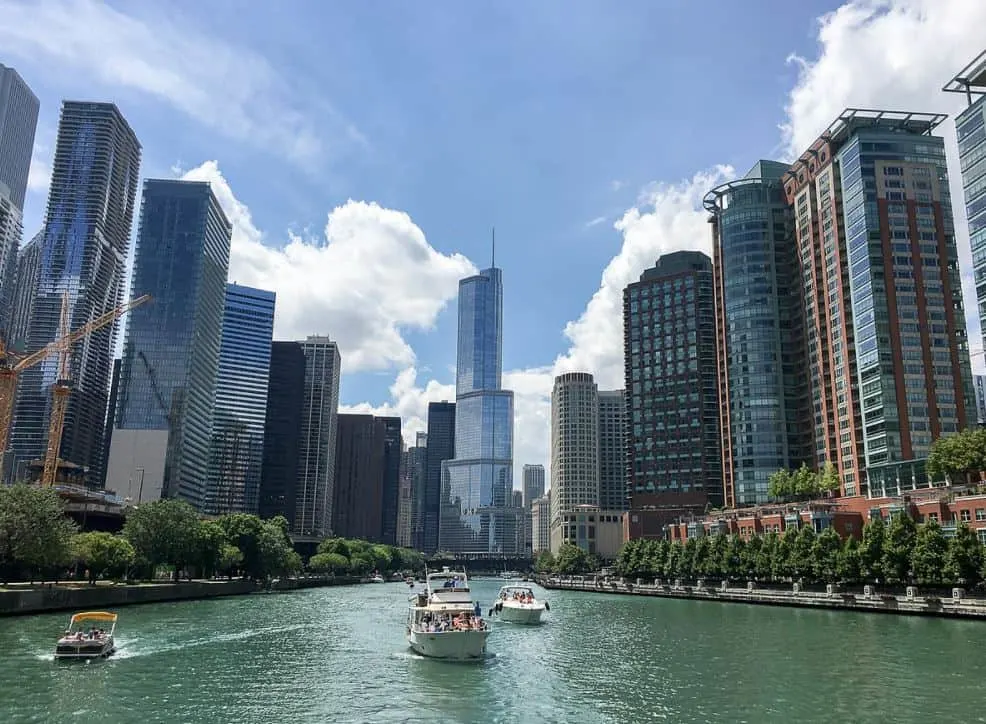Chicago is the capital of the U.S. state of Illinois and the third-most populous city in the United States after New York City and Los Angeles. The city is situated on the shores of Lake Michigan, one of the 5 Great Lakes of North America.
This means that a lot has happened since the first non-Indigenous man named Jean Baptiste Point du Sable, referred to as the “Founder of Chicago,” settled in the area in the 1780s.
The town wasn’t established until 1833 and the city of Chicago was incorporated on March 4, 1837, with a population of fewer than 6,000 inhabitants.
As the city became an important transportation hub that interconnected the Great Lakes named the “Chicago Portage,” the city grew exponentially.
It was the fastest-growing city in the world for many decades in the 19th century and countless construction projects turned this small town into a bustling metropolis.
Let’s take a closer look at some of the most famous buildings in Chicago, architecture that you must check out when you’re in the city!
1. Willis Tower
The Willis Tower was originally called the Sears Tower until 2009 and is still informally referred to as such.
This magnificent skyscraper in Chicago was completed in 1974 and became the tallest building in the world with a height of 442 meters (1,450 feet), surpassing the World Trade Center in New York. It held this remarkable title for 25 years.
The tower is considered to be the ultimate masterpiece of Bangladeshi-American engineer Fazlur Rahman Khan.

It was designed in such a way that it consists of 9 square tubes which are stacked on top of each other in a 3×3 matrix.
It was the first building in the world to use this type of design and it turned out to be very efficient and economic.
Official website: Willis Tower
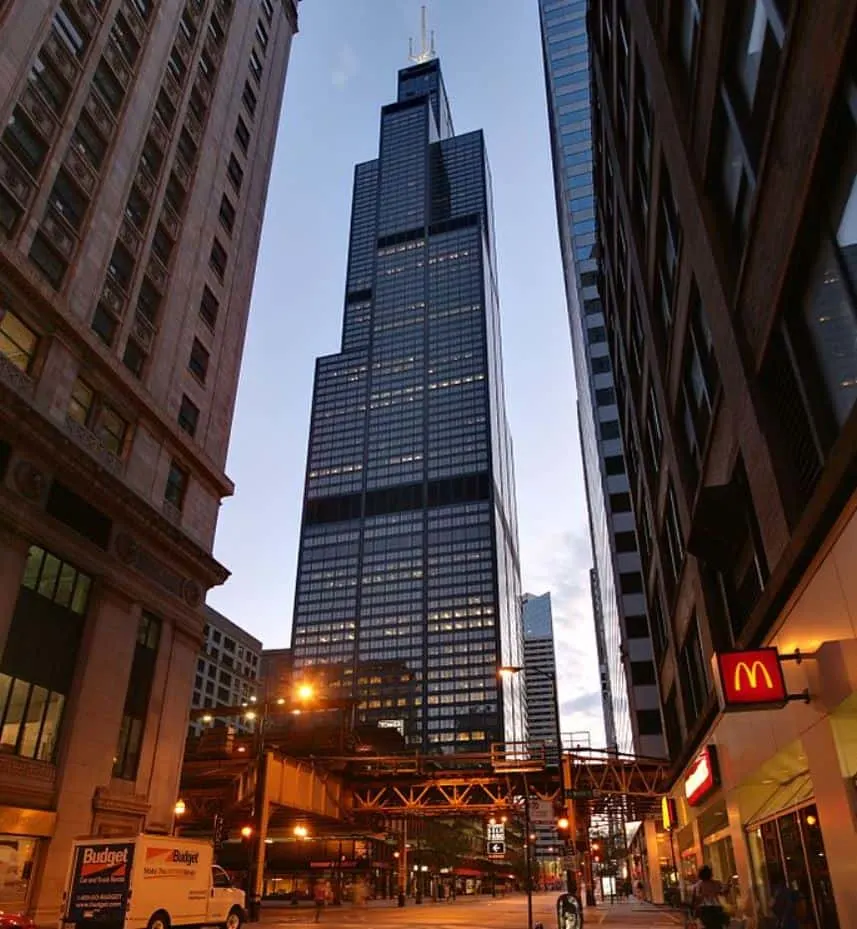
2. John Hancock Center
The John Hancock Center is officially known as “875 North Michigan Avenue” and is located in the Magnificent Mile district of Chicago.
Upon completion in 1968, this astounding skyscraper became the second-tallest building in the world with a height of 343.7 meters (1,128 feet) and the tallest building in Chicago as well.
The tower is named after the John Hancock Mutual Life Insurance Company.
It’s a mixed-used tower with offices and restaurants and features 700 condominiums as well.
Its most famous attraction is the observation deck referred to as “360 Chicago” which offers awesome views of the city’s skyline and the Lake Michigan area.
Official website: 360 Chicago

3. Tribune Tower
The Tribune Tower is another skyscraper that was built in a completely different era, something that clearly shows in its neo-Gothic design which was chosen through an international design competition.
It’s located at 435 North Michigan Avenue and was completed between 1923 and 1925.
The tower was built to become the home of the local newspaper called the “Chicago Tribune.”
This amazing structure stands 140 meters (470 feet) tall and is one of the most prominent landmarks in the Michigan–Wacker Historic District.
Its design was inspired by the design of Cass Gilbert’s Woolworth Building in New York City, a structure that was completed in 1913.
Official website: Tribune Tower
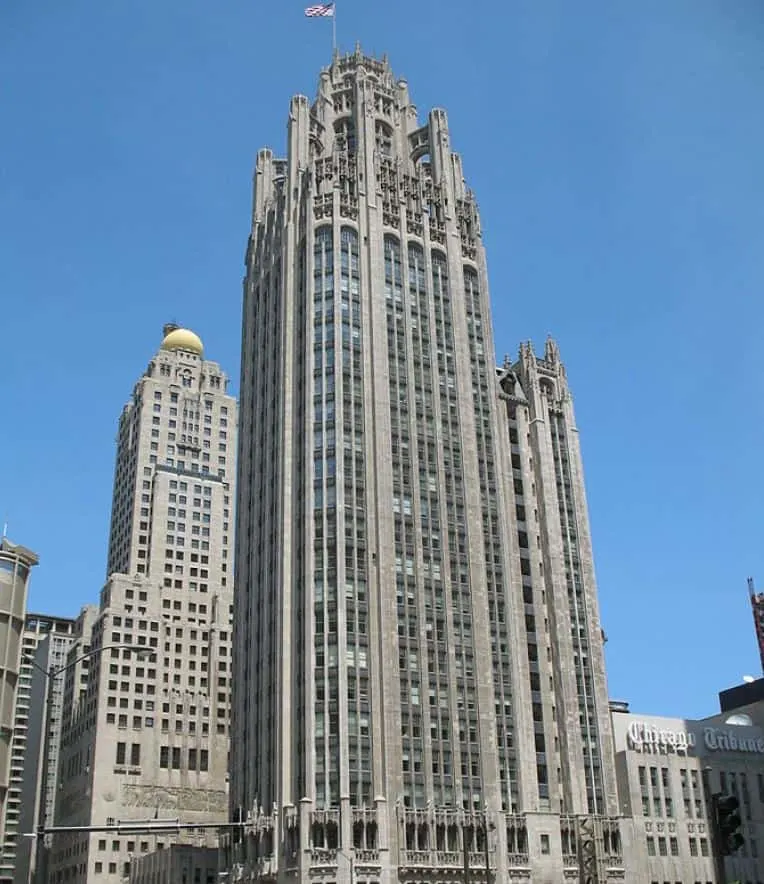
4. Millennium Park
Millennium Park is a public park that is sometimes referred to as the “front lawn of downtown Chicago,” mainly because it’s located right in between this area of the city and the Lake Michigan shoreline.
In reality, this park covers just 24.5 acres (99,000 square meters) in the northwest of the much larger Grant Park which covers an area of 319 acres or 1.29 square kilometers).
As the name suggests, the ark was constructed at the end of the 20th century to celebrate the upcoming new Millennium.
This makes it all the most remarkable that the park only opened on July 16, 2004, 4 years behind schedule to be in time for this amazing event in human history.
In total, USD 475 million was spent on the construction of the park and its attractions.
Official website: Millennium Park

5. Cloud Gate
Cloud Gate is one of the most fascinating landmarks in Millennium Park and is the centerpiece of AT&T Plaza.
This magnificent sculpture was created by British artist Sir Anish Kapoor and was constructed between 2004 and 2006, shortly after Millennium Park opened its doors to the public.
This monument is referred to as “The Bean” because of its remarkable shape and reflects the city’s skyline peculiarly.
You can walk underneath the sculpture as the arch has a height of 3.7 meters (12 feet).
Here you can see the “omphalos,” the Greek word for navel, a location that multiplies the city’s reflections.
Official website: Cloud Gate

6. Art Institute of Chicago
The Art Institute of Chicago is another famous Chicago landmark nearby as it’s located right within Grant Park.
This amazing museum was founded in 1879 and is one of the oldest and largest museums in the United States with a collection size of over 300,000 items and nearly 2 million yearly visitors.
Apart from its extremely large collection, it also features some of the most iconic paintings in art history.
These include Georges Seurat’s “A Sunday on La Grande Jatte” (1886), Pablo Picasso’s “The Old Guitarist” (1904), and Edward Hopper’s “Nighthawks” (1942).
The building itself was designed in the Beaux-Arts architectural style and completed in 1893. It was specially built for the World’s Columbian Exposition that year.
Official website: Art Institute of Chicago

7. Monadnock Building
The Monadnock Building is a fascinating structure for multiple reasons. It was completed in the late 19th century and it’s the tallest load-bearing brick building ever constructed.
The staircases inside the building are also considered to be the first structural use of aluminum in architectural history.
The building was completed in the year 1893 and it instantly became the tallest office building in the world at that time, even though it only has 16 floors.
Even though the lack of decorations was initially criticized, it ended up becoming one of the most influential buildings in the city due to its structural innovations.
It was the first building that was designated as a Chicago Architectural Landmark in 1958 as well.
Official website: Monadnock Building

8. DuSable Bridge
The DuSable Bridge is the most iconic bridge in downtown Chicago.
This remarkable bascule bridge in Chicago carries Michigan Avenue across the Chicago River and therefore forms an important link between the city’s north and south side, even though the bridge only has a total length of 122 meters (399 feet).
The northern part of the bridge used to be the location where Jean Baptiste Point du Sable built his house in the 1780s.
Therefore, the bridge was named after the first non-Indigenous settler in what is now the bustling Chicago metropolis.
The south side of the bridge used to be the site of Fort Dearborn which was constructed in 1803.
Official website: Bridgehouse Museum
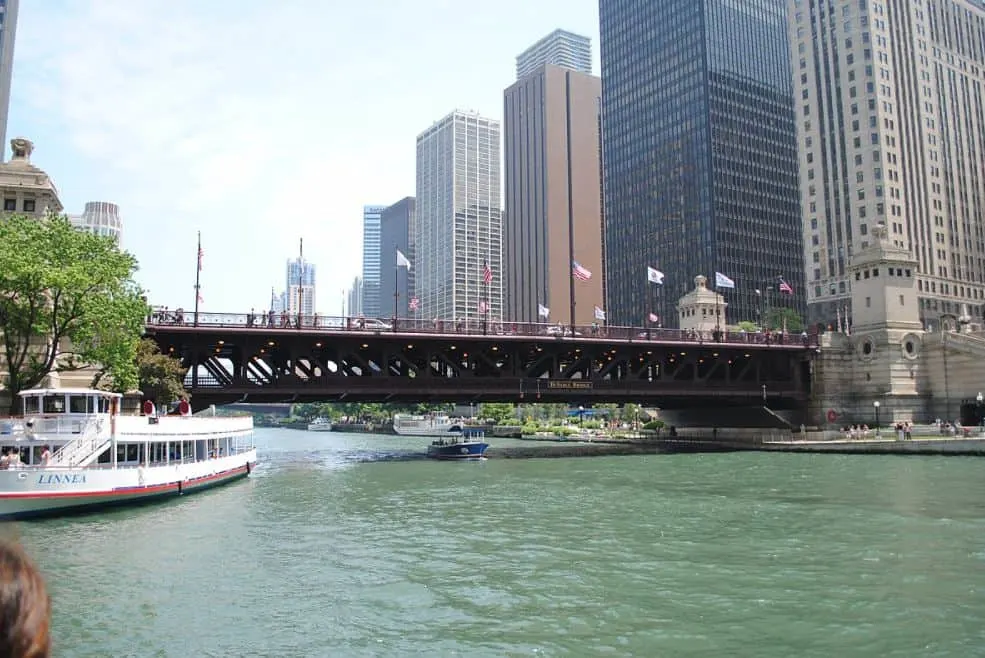
9. Lincoln Park Conservatory
The Lincoln Park Conservatory is an amazing greenhouse and botanical garden situated inside Lincoln Park, a vast public park located along the shoreline of Lake Michigan.
The first greenhouse on the site was constructed in 1877 and the current conservatory was built between 1890 and 1895.
The formal garden in front of the Victorian Era conservatory was established in the late 1870s and is considered to be the oldest formal garden in Chicago.
It has since been decorated with a large number of sculptures and works of art, making it one of the most fascinating places to relax in the city.
Official website: Lincoln Park Conservatory

10. Chicago Theater
The Chicago Theater is one of the most iconic theaters in the world. It was constructed in the year 1921 and was originally referred to as the Balaban and Katz Chicago Theatre
That’s because it was built by the “Balaban and Katz (B&K) group.” It’s situated on North State Street in the Chicago Loop in downtown Chicago.
The complex is currently run by Madison Square Garden, Inc. and is used for a wide variety of entertainment purposes, including stage plays, magic shows, sporting events, and even music concerts.
The theater has a seating capacity of 3,600 and was added to the National Register of Historic Places in 1979.
Official website: The Chicago Theater
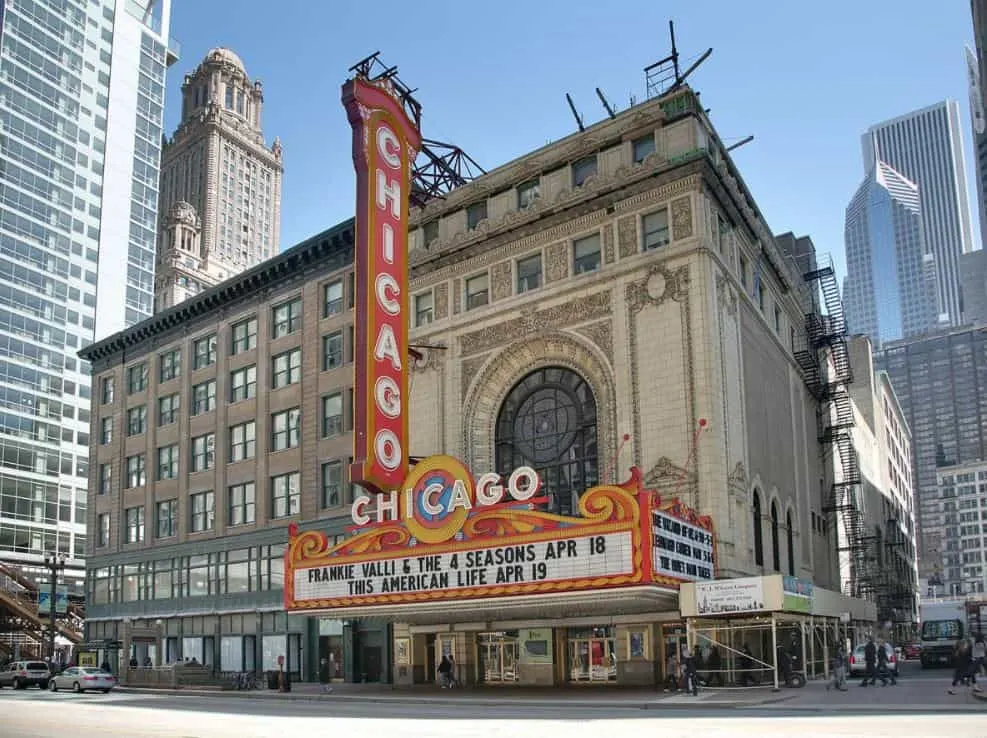
11. Aqua Tower
The Aqua Tower is a fascinating skyscraper located in the Lakeshore East development in downtown Chicago.
The tower stands 261.8 meters (859 feet) tall and has a remarkable design contemporary architectural design that was awarded the Emporis Skyscraper Award in 2009 as the skyscraper of the year.
Equally remarkable is that it’s the world’s tallest building that was designed by a woman, namely Jeanne Gang of Studio Gang Architects.
It was also the firm’s first completed project which makes the award it received all the more remarkable.
Official website: Aqua Tower

12. Chicago Water Tower
The Chicago Water Tower is the most fascinating landmark in the Old Chicago Water Tower District which is situated along the Magnificent Mile.
It was built in the year 1869 which makes it the second-oldest water tower in the United States as only the Louisville Water Tower in Kentucky is older.
The tower stands 55 meters (182.5 feet) tall and is one of the few buildings in the area that survived the Great Chicago Fire of 1871.
Today, the building is used as a tourist attraction and art gallery referred to as the “City Gallery in the Historic Water Tower.”
Official website: Chicago Water Tower

13. Aon Center
The Aon Center is another amazing skyscraper located just east of the Chicago Loop.
It was constructed between 1970 and 1974 and was originally referred to as the Standard Oil Building.
It was transformed into the headquarters of the Aon Group eventually, a company that still has its US headquarters in the building.
Upon completion, it was the world’s tallest marble-clad building and its exterior featured a total of 43,000 pieces of Carrara Marble.
The marble was eventually replaced between 1990 and 1992 using Mount Airy white granite which gives this remarkable structure its unique appearance today.
Official website: Aon Center
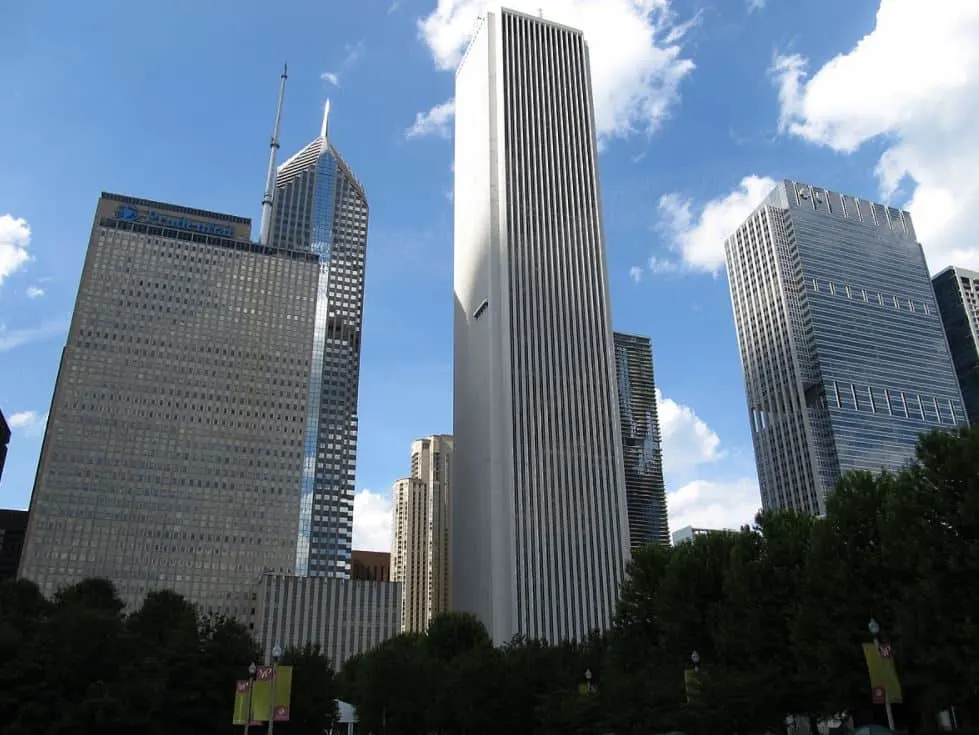
14. Chicago Temple Building
The Chicago Temple Building is another skyscraper that stands 173 meters (568 feet) tall and which is home to the First United Methodist Church of Chicago at its base and upper floors.
The building was constructed between 1923 and 1924 and is considered to be the tallest church building in the world.
It was also the tallest building in Chicago upon completion until it was surpassed by the Chicago Board of Trade Building in 1930.
The top floor of the building features the so-called “Sky Chapel,” a sanctuary at the base of the steeple which has seating space for 30 people.
Official website: The Chicago Temple
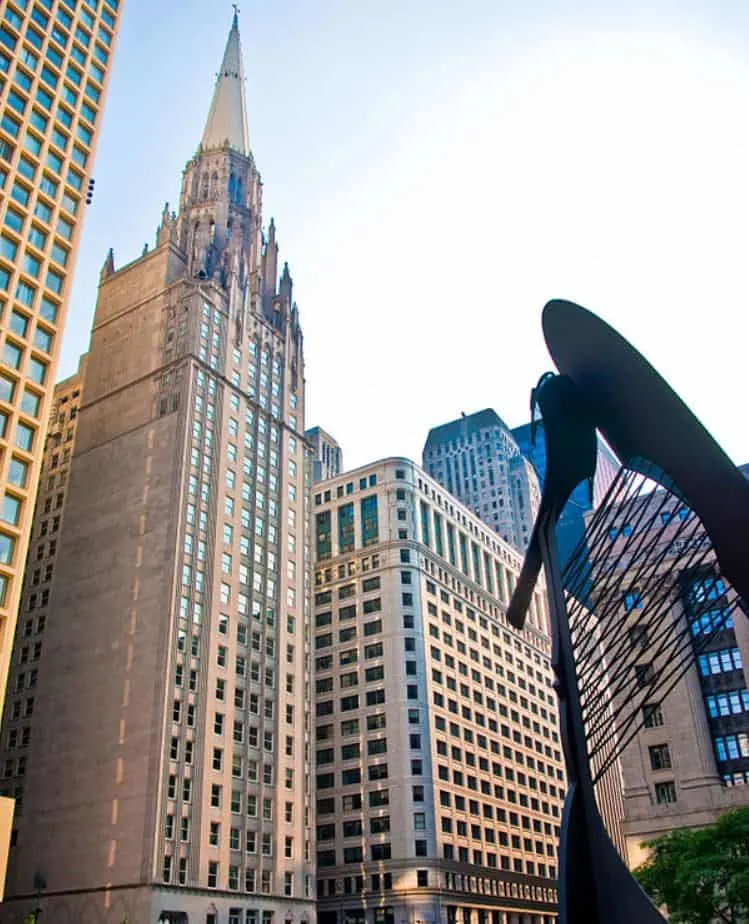
15. Civic Opera House
The Civic Opera House is located inside the Civic Opera Building, a 45-story office tower located at 20 North Wacker Drive.
This huge opera house features the second-largest auditorium in North America with a seating capacity of 3,563 as only the Metropolitan Opera House in New York City is bigger.
The building is the permanent home of the Lyric Opera of Chicago.
It was inaugurated in the year 1929 and the magnificent Art-Deco building was completely renovated between 1993 and 1996.
Official website: Lyric Opera
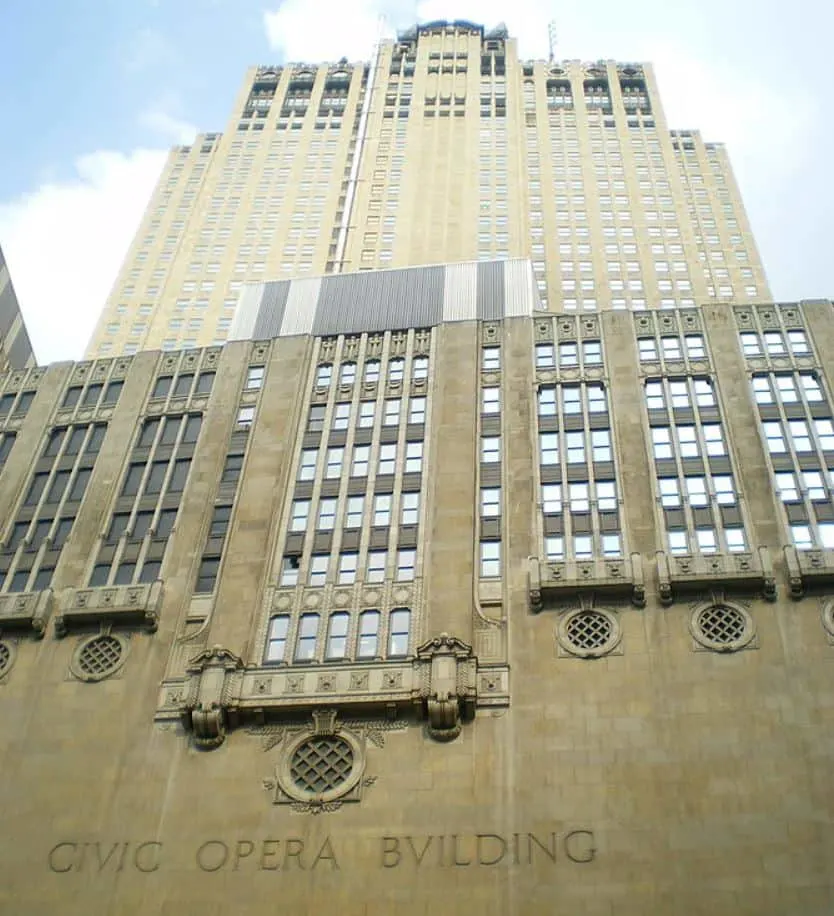
16. Wrigley Building
The Wrigley Building is another one of the famous buildings in Chicago that are located on the Magnificent Mile, right across Michigan Avenue and the Tribune Tower.
It was built between 1920 and 1924 to house the headquarters of the Wrigley Company, an American manufacturer of Chewing gum.
The building consists of two towers and the north and south towers were originally connected on the ground floor and third floor.
An additional walkway was added on the 14th floor in the year 1931. The south tower is the higher one of the two and stands 130 meters (425 feet) tall.
Official website: The Wrigley Building
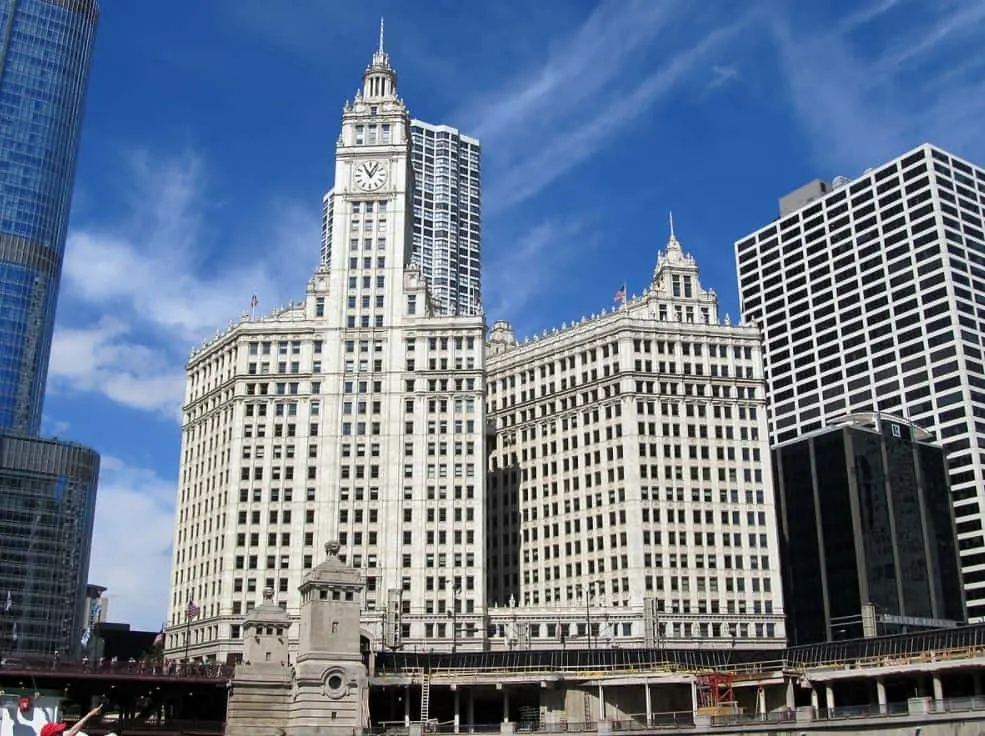
17. Wrigley Field
Wrigley Field was originally constructed in 1914 and opened as the “Weeghman Park” before being named “Cubs Park” between 1920 and 1926.
It’s the home venue of the Chicago Cubs baseball team which was acquired by the Wrigley Company in 1920. It was finally renamed Wrigley Field in 1926.
This iconic baseball park is situated in a residential neighborhood and has no available parking lot.
The rooftops of some of the houses behind the outfield even feature stands from which fans can watch the play.
This turns this amazing sports venue into one of the most remarkable landmarks in Chicago that you simply have to see during your stay in the city.
Official website: Wrigley Field

18. Rookery Building
The Rookery Building is another historic office building located at 209 South LaSalle Street in the Loop.
It was designed by Burnham and Root, one of the most renowned architectural firms in Chicago in the 19th century.
The building was completed between 1886 and 1888 and originally housed the headquarters of this company.
Even though the building only has 12 stories and stands 55 meters (181 feet) tall, it’s considered to be the oldest high-rise building in the city.
It was a revolutionary building as it features exterior load-bearing walls and an interior steel frame. The building was designated a Chicago Landmark in 1972 as well.
Official website: The Rookery
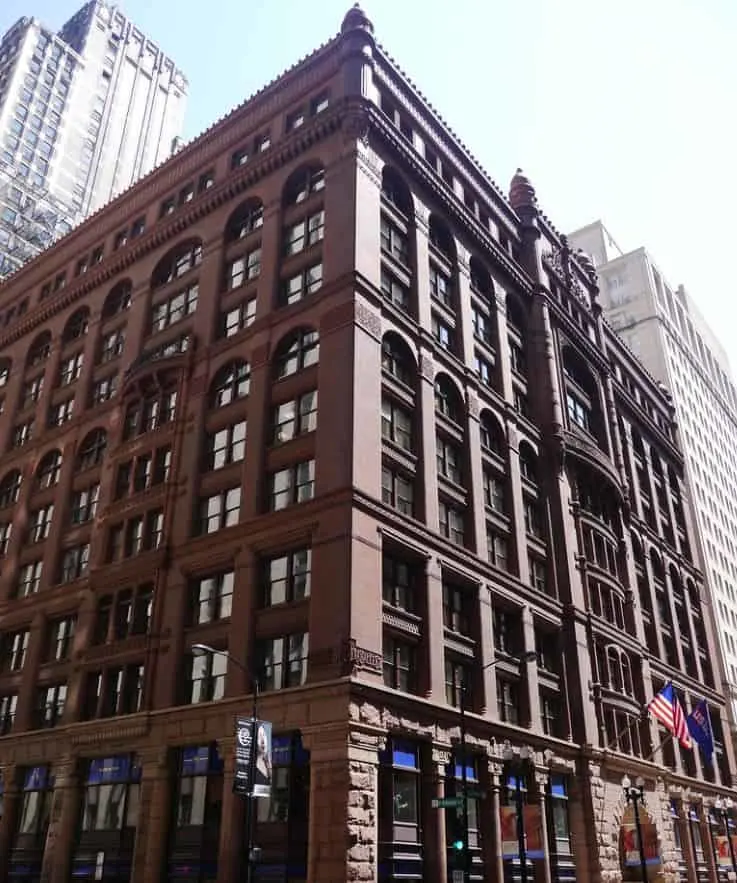
19. Manhattan Building
The Manhattan Building is another structure from around the same period as it was constructed between 1889 and 1891.
It was designed by William Le Baron Jenney (1832-1907), the man who is considered to be the “Father of the Skyscraper” as he built the first skyscraper in the world, the “Home Insurance Building” in 1885.
Even though the first skyscraper in the world isn’t with us anymore as it was demolished in 1931, the Manhattan Building was built similarly.
It’s considered to be the oldest skyscraper still standing that was built solely using a skeletal supporting structure, something that makes this fascinating structure an icon in the city.
Official website: Manhattan Building
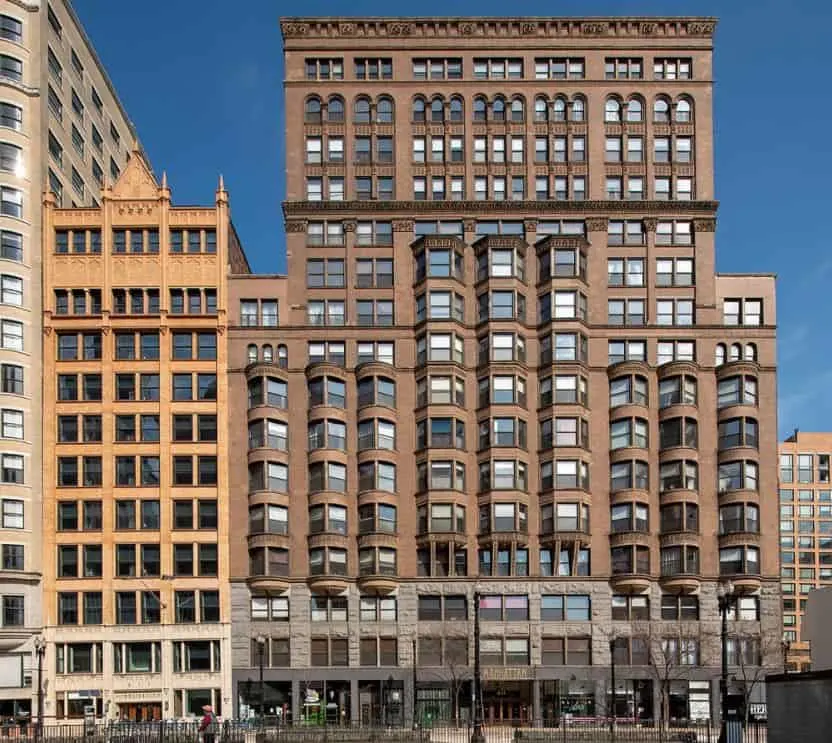
20. Jay Pritzker Pavilion
The Jay Pritzker Pavilion is also referred to as the “Pritzker Music Pavilion” and is an open-air entertainment venue located within Millennium Park near downtown Chicago.
It was built between 1999 and 2004 and is considered to be the centerpiece of this amazing public park.
The pavilion was named after Jay Pritzker, a member of the Pritzker family who owns the Hyatt Hotels.
It’s also the home of the “Grant Park Symphony Orchestra and Chorus” and the venue of the “Grant Park Music Festival.”
The setting is amazing and the pavilion has a total capacity of about 11,000 people during shows!
Official website: Jay Pritzker Pavilion

21. Chicago Riverwalk
The Chicago Riverwalk is one of the most popular areas in the city for tourists to visit as it’s located right in the heart of the city.
This public space is situated on the south bank of the Chicago River and runs from Lake Shore Drive and Lake Michigan to Lake Street.
The area features multiple bars and restaurants, multiple small parks to relax right within the center of the city, and offers tourists boat and kayak rentals to have a great time on the Michigan River.
The area has been continuously extended as well as the Water Plaza, The Jetty, and The Boardwalk sections have been integrated into the Riverwalk since 2016.
Official website: Chicago Riverwalk

22. Merchandise Mart
The Merchandise Mart is often referred to as the “Merch Mart” or simply the “Mart” and is an enormous commercial building in downtown Chicago.
The building was constructed between 1928 and 1930 and became the largest building in the world upon completion with a total floor space of 372,000 square meters (4 million square feet).
The building’s purpose was the centralize all the merchants in the Chicago downtown area. It was originally constructed by Marshall Field & Co. and was subsequently owned by the Kennedy Family for over half a century.
It’s still one of the most fascinating buildings in the world, even though it has been dwarfed by some buildings in China considering floor space.
Official website: The Mart
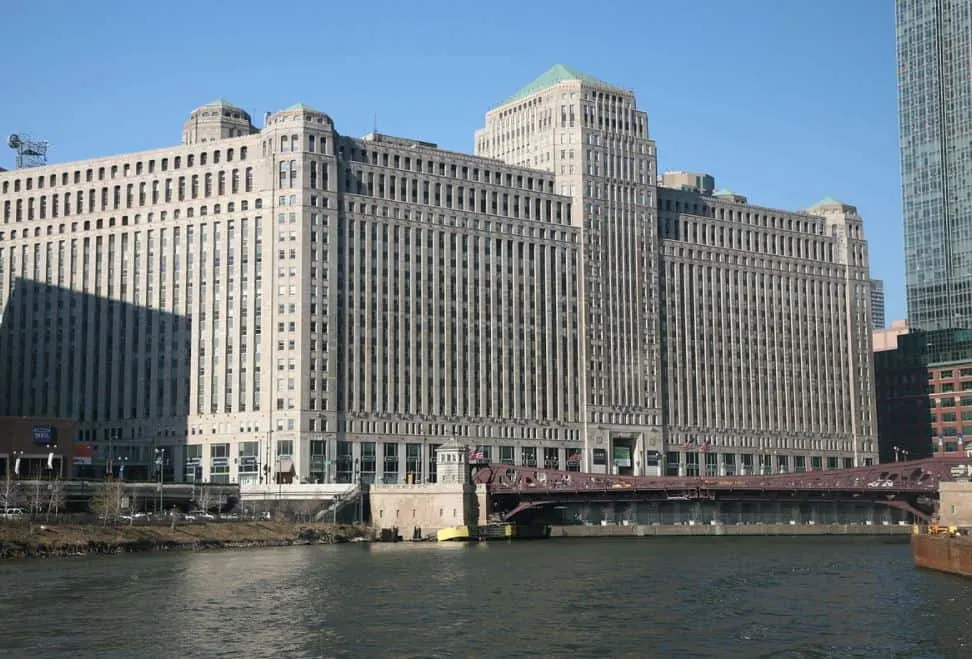
23. Chicago Picasso
The Chicago Picasso is an untitled work of art produced by world-famous Spanish artist Pablo Picasso.
This monumental sculpture is located in Daley Plaza and was completed in the year 1967 after being commissioned by the architects of the nearby Daley Center in 1963.
This remarkable attraction in Chicago was officially inaugurated in the plaza on August 15 of that year.
The sculpture stands 15.2 meters (50 feet) tall and weighs a whopping 147 tonnes.
Even though the work remained untitled, we know that Picasso’s inspiration for the work was one of his most loyal companions, his Afghan Hound named Kabul.
Official website: The Picasso
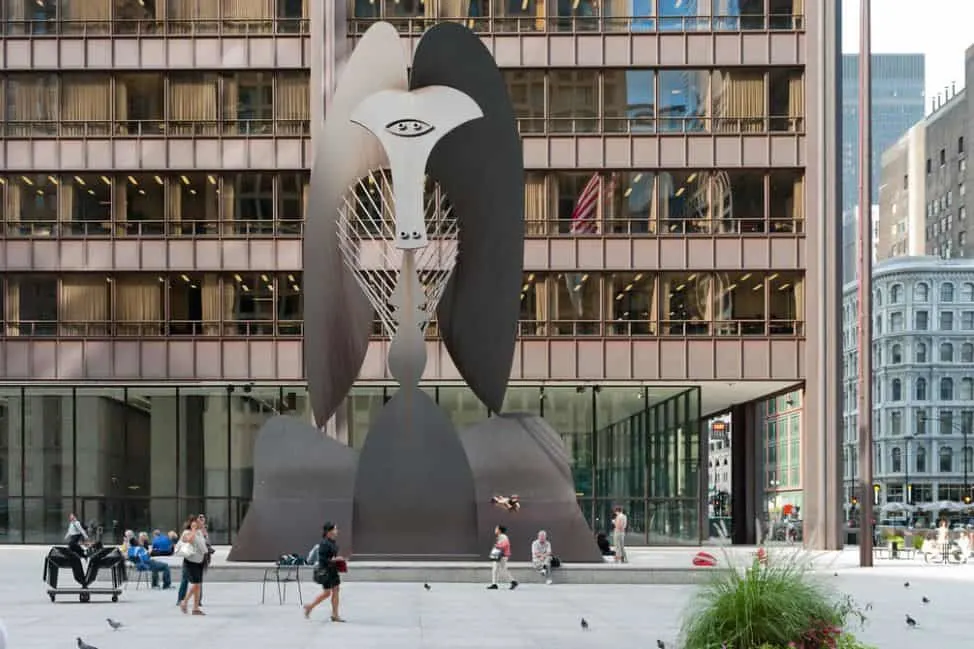
24. Bahá’í Temple
The Chicago Baháʼí Temple is also referred to as the “Baháʼí House of Worship” and is located in the village of Wilmette, about 14 miles (23 kilometers) north of the downtown area of Chicago.
The Baháʼí Faith is a religion that was established in the 19th century that teaches about the essential worth of all religions and the unity of all people.
The structure in the Chicago metropolitan area was only the second of its kind to be ever constructed and the oldest surviving temple in the world.
It was constructed between 1912 and 1953 after being delayed by both the Great Depression and World War II.
Official website: Bahá’í Temple
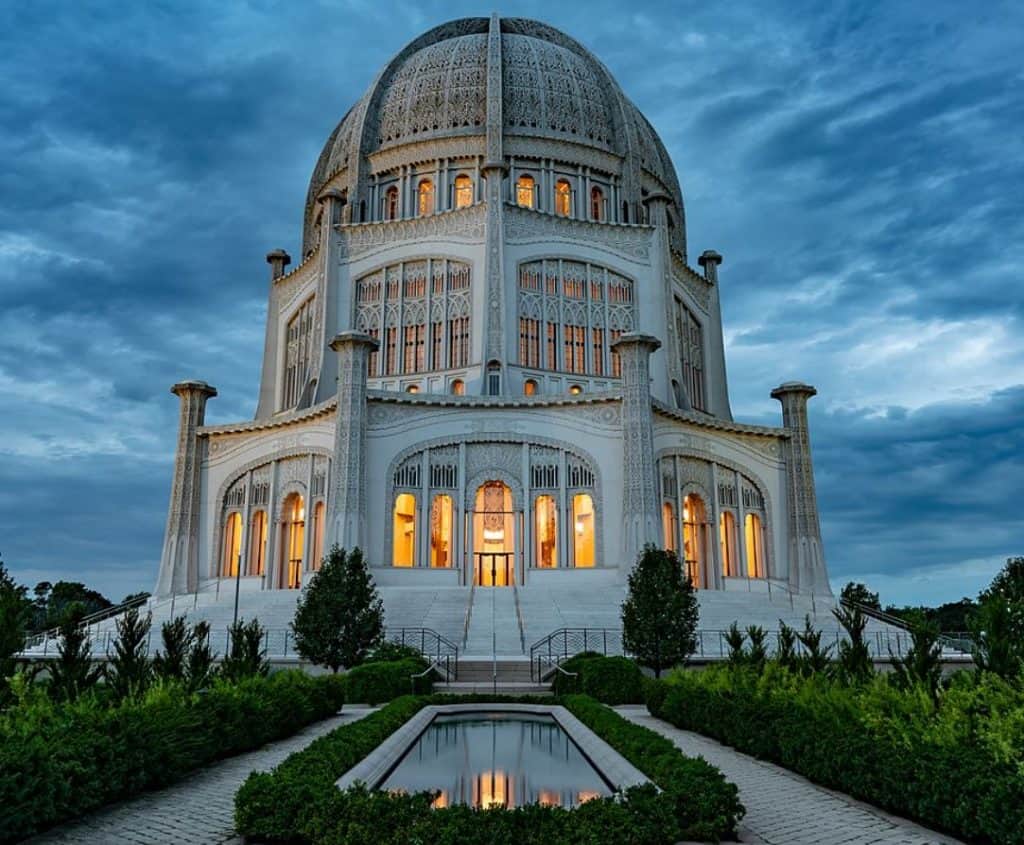
25. Adler Planetarium
The Adler Planetarium is a public museum located at the northeast tip of Northerly Island along the shore of Lake Michigan.
It was founded in 1930 by the man it was named after, Max Adler (1866-1952), a rich entrepreneur in the Chicago area who was on a mission to explore and understand the universe.
The museum is dedicated to the study of astronomy and astrophysics and was the first of its kind to open in the United States.
It’s one of the museums comprising Chicago’s Museum Campus with the other ones being the John G. Shedd Aquarium and The Field Museum.
Official website: Adler Planetarium
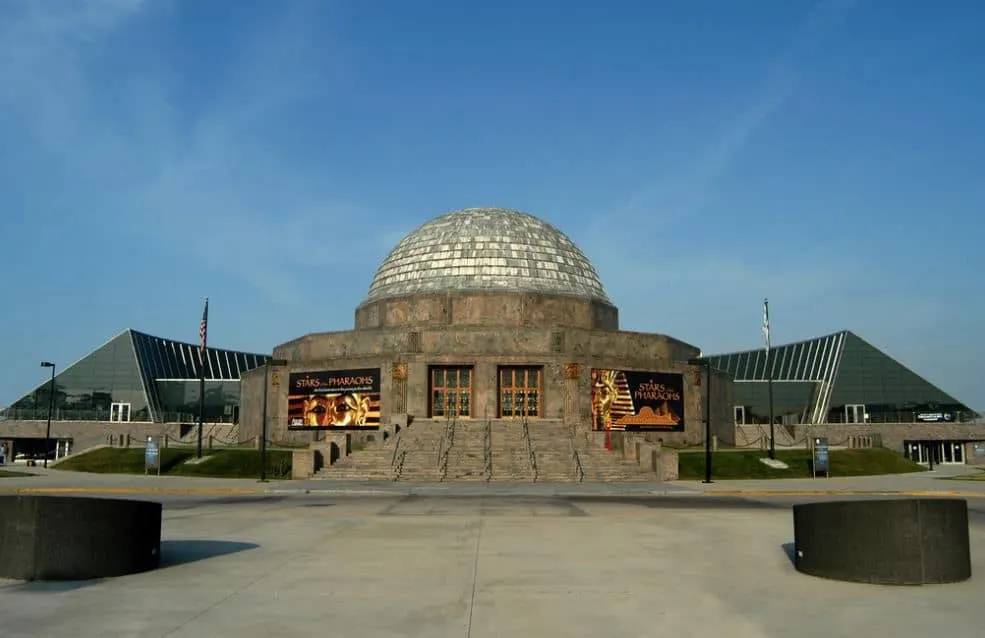
26. Buckingham Fountain
Buckingham Fountain is another fascinating tourist attraction in the city located right in the center of Grant Park near downtown Chicago.
It’s one of the largest fountains in the world and was inaugurated in the year 1927. The bottom pool of the fountain has a diameter of 85 meters (280 feet).
The fountain was inspired by the Latona Fountain at the Palace of Versailles and produces amazing light shows in the evening.
The fountain contains an astounding 1.5 million U.S. gallons (5,700,000 liters) of water and its jet shoots up to 46 meters (150 feet) vertically in the air.
Official website: Buckingham Fountain

27. Chicago Architecture Center
The Chicago Architecture Center was founded in 1966 as the Chicago Architecture Foundation and is a nonprofit organization that aims to educate people about architecture in the city.
The headquarters of this organization has a scale model of downtown Chicago on display.
The most amazing way to explore the city is by taking an architecture cruise on the Chicago River in which docents explain the wide variety of architectural styles found throughout the city.
In our opinion, it’s the best way to discover the most fascinating buildings in Chicago.
Official website: Chicago Architecture Center
